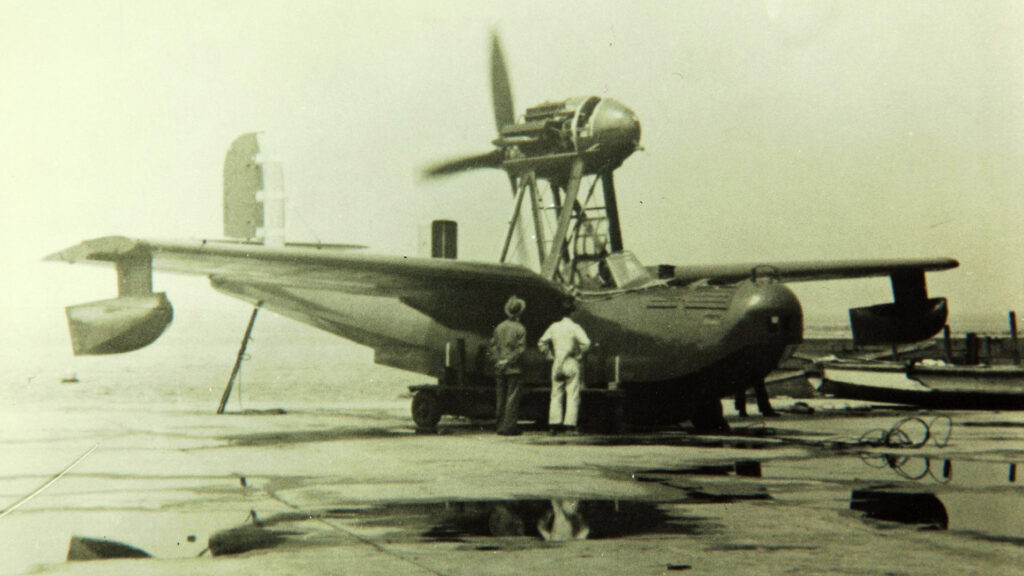 Kawanishi E11K, a Japanese experimental flying boat performed its first flight.
Kawanishi E11K, a Japanese experimental flying boat performed its first flight.
The story of this aircraft began in 1936, when the Imperial Japanese Navy drew up a request for a new small flying boat, intended for night reconnaissance purposes and able to replace a then-used Aichi Navy Type 96 Reconnaissance Seaplane.
Project of Type 96 successor was designated Experimental 11-Shi Special Reconnaissance Seaplane. Contracts for its development and construction were awarded to two of Japan’s leading aerospace manufacturers at the time, Aichi and Kawanishi. Both have already built a series of aircraft for the IJN before.
Those two designs were quite different from each other. Aichi proposed an aircraft named AB-14, being a biplane that construction quite strongly resembled its predecessor. On the contrary, a Kawanishi-designed seaplane, designated E11K1, was an all metal, gull-wing cantilever monoplane, equipped with retractable floats on the wing tips.
Initially, the E11K1 was powered by a 620 hp, 12-cylinder Hiro Type 91-1 W engine, fitted with a wooden four-blade pushing propeller. The power unit was mounted on a pylon on top of the fuselage, just behind the pilot’s cabin and the engine was cooled by a water radiator, located in the rear section of the fuselage just behind the propeller. This solution allowed the prop wash to be used for better cooling, which was particularly useful while the flying boat was still on water or when flying at low speed. In addition, the aircraft was designed to be able to operate from cruiser ships. It was developed for optional catapult launches and had a unique solution of rearward folding wings for easier storage.
Work on prototype of the Kawanishi E11K1 flying boat began in October 1936 and just about nine months later, on 11th June 1937, it made its first flight. Then, on 27th June, it was handed over to the IJN for testing. Evaluation trials conducted by the Navy quickly revealed shortcomings and under-performance of the aircraft. First of all, the E11K1 was heavier than expected. The engine mount and the floats retracting system were problematic, the aircraft was unstable both in flight and on water and had a poor water handling characteristics. In fact, the previous design of that manufacturer – the E10K1 seaplane – also faced similar problems
As a result, it was the AB-14 that was eventually selected as the next night reconnaissance aircraft for the Imperial Japanese Navy, receiving an official military designation of Navy Type 98 Reconnaissance Seaplane. However, that decision, and the fact that the E11K1 was hardly suitable as a reconnaissance aircraft, did not mean the end of the story for the Kawanishi design.
Soon, both of the manufactured Kawanishi E11K1 prototypes underwent some modifications. Thanks to addition of retractable landing gear, the aircraft were transformed into amphibious flying boats (similar conversion was also made to the previously mentioned E10K1). Their current power units were replaced by engines of the same family, albeit more powerful – Hiro Type 91-2 of 750 hp.
Only then those flying boats were finally accepted by the command of the Imperial Japanese Navy. After receiving official designation Navy Type 96 Transport, both examples were assigned to reconnaissance seaplane squadrons and served there as command liaison aeroplanes yet during the World War II.
In a word of conclusion, it is worth giving some additional information on the Kawanishi Navy Type 96 Transport aircraft. The flying boat was crewed by three men – pilot, co-pilot and observer/gunner. Its armament consisted of a single flexible 7.7 mm machine gun, installed in the nose of the aircraft. Cruising speed of the seaplane was just 130 kph (81 mph), while its top speed was 207.6 kph (129 mph). Another flying characteristics were reported as: operational ceiling of 4,200 metres (13,779 ft), range of 1,519 kilometres (820 nmi) and flight duration of up to 8.4 hours.
Cover photo: Kawanishi E11K1, from a collection of San Diego Air and Space Museum Archive, via Flickr Commons licence.
Based on: ‘Japanese Aircraft 1910-1941′ by Robert C. Mikesh and Shorzoe Abe, 1990



